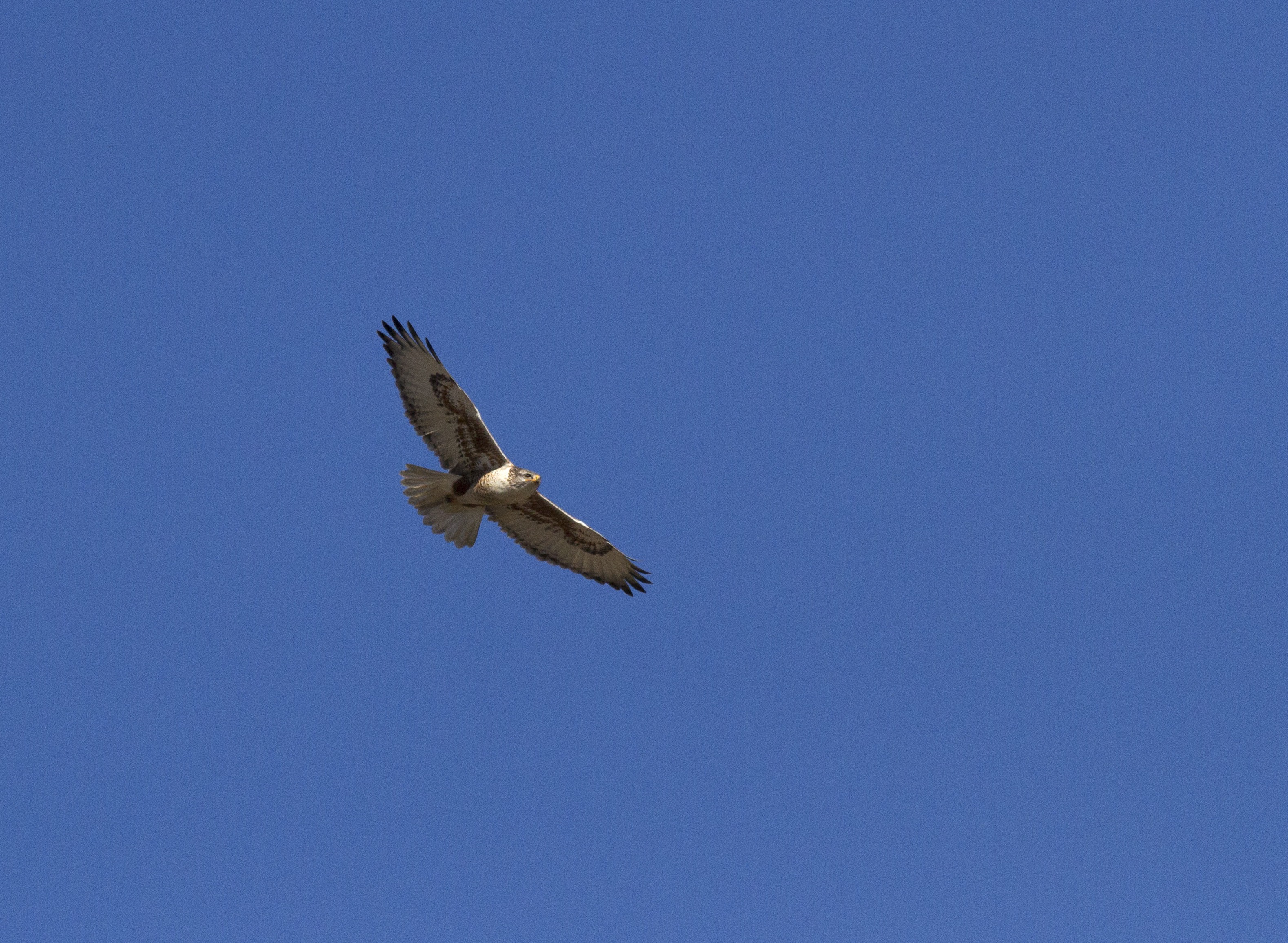
Ferruginous Hawk
Buteo regalis
Buteo regalis
SJWA, Riverside County
Photo Credit: PJ Falatek
| Historically present | |
| Between 2000 and | |
| Last 10 years |
|
Regional Grazing Monitoring Plan
This project evaluates using grazing as a management tool for degraded grasslands and coastal sage scrub habitat. Pilot projects will be conducted to look at the efficacy of grazing as management tool and necessary monitoring methods. The project was designed to answer four primary questions (and their associated objectives): 1) How effective is grazing at reducing fire risk? 2) Can grazing effectively enhance disturbed native grassland and forb habitats 3) Can grazing enhance disturbed native coastal sage scrub habitat? 4) Can grazing reduce nonnative grass and forb cover in disturbed coastal sage scrub to increase native shrub cover and bare ground and improve habitat for MSP species such as Quino checkerspot butterfly (Euphydryas editha quino), California gnatcatcher (Polioptila californica), black-tailed jackrabbit (Lepus californicus), burrowing owl (Athene cunicularia hypugaea), and Stephen' kanagroo rat (Dipodomys stephensi)? Initial study sites were established at Rancho Jamul Ecological Reserve and Hollenbeck Canyon Wildlife Area, and the project has recently expanded to Ramona. This is a SANDAG-funded project.
|
| File name | Lead Author | Year | Type |
|---|---|---|---|
| County of San Diego MSCP Monitoring Summary Report January 1998 - June 2007 | County of San Diego | 2007 | report |
| Ramona Grasslands: Historical Perspective | Bittner, David | 2008 | report |
Ferruginous Hawks generally breed from the central regions of Canada along the country’s southern border to the western regions of the U.S., south to Arizona and New Mexico and east to the Dakotas, Nebraska, Kansas, Oklahoma, and Texas [1]. Wintering ranges include most of California, central and southwestern Colorado, southern Nevada, Arizona and New Mexico, southwestern Nebraska, western Kansas, Oklahoma, Texas, and down into Mexico [1].
Occurs in San Diego County from October to March. Distribution is patchy and corresponds to the larger tracts of grasslands [2]. During winter, populations have been documented in the east arm of Warner Valley, upper basin of Lake Cuyamaca, Ramon, Fallbrook weapons station, Borrego Valley, and the largest numbers were located at Lake Henshaw [2].
Not listed
Ideal habitat is grassland and shrub-steppe habitat including pastures, hayland, and cropland [3]. Nests can be found in trees and large shrubs and on tops of buildings, man-made structures or platforms, and near the ground on river cliffs [4].
The Ferruginous hawk (Buteo regalis), has no recognized subspecies [4].
Year-long, diurnal activity [5]. Resident of California primarily during winter. Hawks from northern areas will migrate to California. They will relocate downslope and south from areas of heavy snow in autumn and return in spring.
Nesting begins in April in the northern U.S., and around March in the southern to mid-latitudes [2]. Generally prefer to build nests in elevated areas, but tend to nest the lowest of all the Buteos. Clutch size 2-4 eggs, but can range up to 8 depending on prey abundance. Hatchlings are altricial and very sensitive to hot climates. The female will leave the nest after 3 weeks, begin to hunt, and detach from the chicks gradually. Young typically fledge between 40 and 50 days after hatching, with males fledging slightly earlier than females [1].
Diet consists of mostly ground squirrels, pocket gophers, and white-tailed jack rabbits [3]. Also feed frequently on prairie dogs and other burrowing animals [5]. Ferruginous Hawks are patient hunters that often wait from perched elevated spots to launch directly at their prey or in front of rodent dens, waiting for the unsuspecting animals to emerge [6].
The breeding areas and winter prey of the Ferruginous hawk has greatly reduced due to human disturbances, such as the taking of suitable habitat in exchange for energy, agriculture, recreation, and development for humans [2].
[1] Bechard, Marc J. and Josef K. Schmutz. 1995. Ferruginous Hawk (Buteo regalis), The Birds of North America Online (A. Poole, Ed.). Ithaca: Cornell Lab of Ornithology; Retrieved from the Birds of North America Online: http://bna.birds.cornell.edu/bna/species/172
[2] Unitt, Philip, Ann E. Klovstad, William E. Haas, Patrick J. Mock, Kirsten J. Winter, and Anthony Mercieca. 2004. San Diego County bird atlas. San Diego: San Diego Natural History Museum.
[3] Dechant, J. A., M. L. Sondreal, D. H. Johnson, L. D. Igl, C. M. Goldade, A. L. Zimmerman, and B. R. Euliss. 1999 (revised 2002). Effects of management practices on grassland birds: Ferruginous hawk. Northern Prairie Wildlife Research Center, Jamestown, ND. 23 pages.
[4] Goodrich, L.J., and J.P. Smith. 2008. Raptor migration in North America. Pp. 37-149 in K.L. Bildstein, J.P. Smith, E. Ruelas Inzunza, and R.R. Veit (eds.), State of North America's birds of prey Nuttall Ornithological Club, Cambridge, MA, and American Ornithologists' Union, Washington, D.C
[5] Zeiner, D.C., W.F.Laudenslayer, Jr., K.E. Mayer, and M. White, eds. 1988-1990. California's Wildlife. Vol. I-III. California Depart. of Fish and Game, Sacramento, California.
[6] Bakker, K. K. 2005. South Dakota All Bird Conservation Plan. South Dakota Department of Game, Fish and Parks, Wildlife Division Report 2005-09.
[7] Wheeler, B.K., C.M. White and J.M. Economidy. 2003. Raptors of Western North America: The Wheeler Guide.